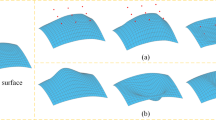Abstract
This paper presents a new approach to the shape optimization of road speed humps. The proposed approach is based on multiobjective genetic optimization of the hump profile while taking into account the separation phenomenon, which occurs when the front tires of the vehicle momentarily lose contact with the road surface. The optimization is carried out for speeds up to twice the authorized speed (throughout this article, the term authorized speed refers to speed limits enforced in speed reduction [bump] areas of the roads) rather than for illegally high speeds as adopted by many of the previous works. A 6-degree of freedom non-linear dynamic model is used to identify the speeds at which separation occurs, and hump profiles associated with these speeds are discarded as infeasible solutions. Three independent objective functions are selected for optimization. They include the maximum vertical acceleration experienced by the driver when crossing the hump below the authorized speed limit (to be minimized), the same vertical acceleration at speeds above the authorized speed (to be maximized), and the ascending ratio of the “speed—vertical acceleration” curve (to be maximized). These objective functions are evaluated for more than 10,000 humps of two popular profile types (sinusoidal and flat top with straight ramps) and optimum profiles for three speed limits of 20, 25, and 30km/h are determined using the multiobjective nondominated sorting genetic algorithm II. As a result, a Pareto front of at least ten optimal points is achieved for each of the two hump profile types. Furthermore, to incorporate the economical aspects of the real-world problem, Pareto optimal points for the two profile types were compared based on their lateral section areas (an indication of the manufacturing cost). The comparison shows that sinusoidal humps more often than not outdo their flat top rivals economically.
Similar content being viewed by others
References
Clark DE (2000) All-way stops versus speed humps: which is more effective at slowing traffic speeds? In: Proceedings of the ITE Annual Meeting Compendium
Clement J (1983) Speed humps and the Thousand Oaks experience. ITE J 53:35–39 (January)
Deb K, Agarwal RB (1995) Simulated binary crossover for continuous search space. Complex Syst 9:115–148
Deb K et al (2002) A fast elitist multi-objective genetic algorithm: NSGA-II. IEEE Trans Evol Comput 6:182–197
Ewing R (1999) Traffic calming state of practice. Institute of Transportation Engineers, Federal Highway Administration, US Department of Transportation, Washington, DC
Fwa TF, Liaw CY (1992) Rational approach for geometric design of speed-control road humps. Transp Res Rec 1356:66–72
Fwa TF, Tan LS (1992) Geometric characterization of road humps for speed-control design. J Transp Eng 118:593–598
ITE (1997) Traffic engineering council speed humps task force. Guidelines for the design and application for speed humps. Institute of Transportation Engineers, Washington, DC
Jarvis JR (1992) An investigation of road humps for use on bus routes. Research Report ARR no. 222. Australian Road Research Board, Victoria, Australia
Khorshid E, Alfares M (2004) A numerical study on the optimal geometric design of speed control humps. Eng Optim 36(1):77–100
Khorshid E, Alfares M (2007) Model refinement and experimental evaluation for optimal design of speed humps. Int J Veh Syst Model Test 2(1):80–99
Lawson RW (2003) The objections to speed humps. Bromley Borough Roads Action Group, London (Submission to the London Assembly)
Moinat P (1991) Étude et Simulation du Passage d’un Véhicule Sur un Dos d’Âne: prédiction de l’Inconfort [A study and simulation of vehicle passage on speed humps: prediction of discomfort]. Master of Engineering Thesis, Université de Sherbrooke, Canada
Nikkhah Bahrami M (2002) Theory of vibration with application in engineering. University of Tehran, Iran (In Persian)
Pedersen NL (1998) Shape optimization of a vehicle speed control bump. J Struct Mech 26:319–342
Raghuwanshi MM, Kakde OG (2004) Survey on multiobjective evolutionary and real coded genetic algorithms. In: Proceedings of the 8th Asia Pacific Symposium on Intelligent and Evolutionary Systems, 6–7 December 2004, Cairns, Australia
Srinivas N, Deb K (1994) Multiobjective optimization using nondominated sorting in genetic algorithms. Int J Evol Comput 2:221–248
Watts GR (1973) Road humps for the control of vehicle speeds. Transport and Road Research Laboratory Report no. 597. Department of Environment and Department of Transport, Crowthorne, UK
Weber P, Braaksma J (2000) Towards a North American geometric design standard for speed humps. ITE J 70(1):30–34
Zhou K et al (2000) Robust and optimal control. Prentice Hall, Englewood Cliffs, NJ
Author information
Authors and Affiliations
Corresponding author
Rights and permissions
About this article
Cite this article
Ansari Ardeh, H., Shariatpanahi, M. & Nikkhah Bahrami, M. Multiobjective shape optimization of speed humps. Struct Multidisc Optim 37, 203–214 (2008). https://doi.org/10.1007/s00158-008-0226-7
Received:
Revised:
Accepted:
Published:
Issue Date:
DOI: https://doi.org/10.1007/s00158-008-0226-7




